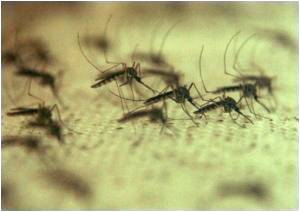A new study has found malaria transmission in many parts of Benin was drastically reduced by indoor spraying with the insecticide bendiocarb.

Scientists with Benin's Entomologic Research Center in Cotonou evaluated the effects of two applications of bendiocarb in homes throughout the West African country over an eight-month period in 2009. They found that after "indoor residual spraying" or IRS, which involves applying insecticide on walls where mosquitoes are likely to land, none of the 350,000 household members living in the treated homes "received infected bites" from the malaria-carrying mosquito Anopheles gambiae.
Moreover, none of the mosquitoes collected from the treated homes tested positive for the Plasmodium falciparum—the world's most deadly malaria parasite. The absence of infected bites and parasites was seen as evidence that malaria transmission had fallen precipitously in an area where mosquitoes have developed resistance to permethrin and other members of a popular class of insecticides known as pyrethroids.
"Our success in drastically reducing malaria transmission by spraying homes with bendiocarb, which is not a pyrethroid, is very important because pyrethroid-resistance is emerging not just in Benin but also in Kenya, Niger, Nigeria, Mali, Cameroon and many other African countries," Gil Germain Padonou, MSc, a medical entomologist, who co-authored the study. "Our results should provide reassurance that despite the rise in pyrethroid resistance, indoor spraying can continue to play a vital role in reducing the incredible burden of malaria across Africa."
The successful lifecycle of the malaria parasite depends on constantly moving from mosquitoes to humans and from humans back to the mosquito. Indoor spraying and bednets disrupt this lifecycle by broadly preventing mosquitoes from an opportunity to feed on infected blood and thus obtain and transmit the malaria parasite. The researchers believe that where there was indoor spraying, malaria transmission likely continued at a very low level difficult to detect. They conclude that it would have required analyzing "thousands of mosquitoes to find any positive for malaria parasites."
While the study did not formally collect data on how the spraying affected malaria illnesses and deaths, Padonou said there are anecdotal reports from doctors in the region of a "significant reduction in malaria cases" in their clinics following the IRS campaign. Virtually all of Benin's 9.3 million people are at risk of malaria infections. Each year, malaria sickens more than a million people in Benin and kills thousands. Malaria accounts for about a quarter of all hospital admissions in Benin and a third of the deaths in children under five.
Advertisement
The indoor spraying campaign in Benin was conducted by the country's National Malaria Control Program, with support from the U.S. through the President's Malaria Initiative. This is part of a broad effort to find alternatives to pyrethroids, the mainstay of public health campaigns against malaria, chiefly through the distribution of insecticide-treated bednets (ITNs) and indoor spraying campaigns. Malaria experts point to wider use of both interventions—coupled with greater access to malaria medicines and diagnostics—as a key reason why malaria deaths in Africa have dropped by more than a third over the last decade, which represents about 1.1 million lives saved.
Advertisement
"Insecticide resistance has been lurking for several years now as a spoiler for the incredible success we have seen in fighting malaria, particularly in Africa, where most of the world's malaria deaths occur," said Peter J. Hotez, MD, PhD, president of the American Society of Tropical Medicine and Hygiene. "We need to intensify support for efforts to develop and test new insecticides and seek better strategies for using them, such as rotating among several different compounds that make it harder for mosquitoes to become resistant. Keeping a constant flow of new products and technologies in pipeline requires funding. If we backpedal now on research and development, we could lose not only the chance to eradicate malaria, but there is also the very real potential we could see an uptick in absolutely preventable malaria diseases, especially among children. This would be unacceptable by any metric."
Padonou and his colleagues worked with the Malaria Control Program to evaluate the capacity of both indoor spraying with bendiocarb and much wider use of ITNs (which continue to be treated with pyrethroids) to interrupt malaria transmission.
Indoor spraying was tested in homes in what is known as the plateau region of Benin, which alternates between wet and dry seasons. But in swampy, frequently flooded areas of Benin, there was concern that indoor spraying with any malaria-killing insecticides could produce toxic runoff into local waterways. Therefore, public health officials opted for increased distribution of ITNs as the primary tool for reducing transmission
The study reports that both indoor spraying and treated bednets demonstrated a capacity to significantly decrease malaria transmission. For the areas that received indoor spraying, infected bites declined by 94 percent overall during the eight-month study, though in some villages scientists believe infected bites stopped altogether. No one living in a treated home received an infected bite. Bites from infectious mosquitoes also declined substantially in areas where there was increased distribution of ITNs, though the drop was about 5 percent less than what was achieved via indoor spraying.
In contrast, in an area of Benin that received neither indoor spraying nor increased access to treated nets, each resident received an average of 120 infected bites over the same period.
"The best way to control malaria would be to use both indoor spraying and treated bednets, at the same time," Padonou said. Bednets protect people from mosquitoes that may first land and "feed" on a human before lighting on a treated surface and indoor spraying kills mosquitoes en masse offering protection even when you are not sleeping. "Such an approach is too expensive for most national malaria programs and should be reserved for areas that have a particularly high level of malaria."
Researchers are now on the lookout for bendiocarb resistance. Padonou said there is early evidence of resistance in a mosquito population in neighboring Burkina Faso, demonstrating a need to develop multiple alternatives to pyrethroids.
Source-Eurekalert












